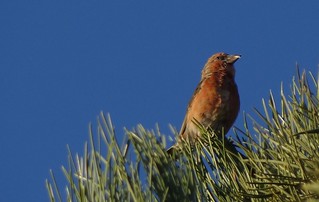Forgive the alliteration—it’s the lowest of poetic figures—but there really isn’t any other way to say it.
The rhythms of bird migration are so regular, so reassuring, that any deviation is bound to inspire uncertainty in the human observer. In no case is this more striking than in the so-called winter invaders, birds whose winter wanderings take them far out of their “normal” range on an unpredictable schedule and sometimes in unsettlingly large numbers. A classic example: the Bohemian waxwing, whose infrequent incursions into western Europe were long believed to presage war, starvation, and plague.
Crossbills, too, with their even more erratic habits, were suspected of serving as harbingers of evil. In 1603, Caspar Schwenckfeld, the Silesian physician, naturalist, and antiquarian, noted that the crossbill invasion of 1596/97, in which “huge” flocks were seen even in towns and villages, had been quickly followed by famine and pandemic.
Even more disturbing is the notion that these birds put their bizarre bills to use not just in cracking pine cones and scarfing up sunflower seeds—no, crossbills, some say, also dine on carrion. I do not know who introduced this idea into the scientific record, but it goes back to at least Gesner, half a century before Schwenckfeld, and it was still being reported by Jan Jonston nearly half a century after.
All of the references I have found to this belief are expressly second-hand: Gesner writes “I have heard that,” Aldrovandi “they say that,” Jonston “as some report,” crossbills eat flesh. None of those authors will vouch for that assertion on his own experience, none of them is able to name his sources. I am fairly sure that I have now read every word published about crossbills before the 1555 publication of Gesner’s ornithology, and I cannot locate a single claimed observation of crossbill carnivory.
Moving the other direction, though, with a look to the scientific literature published after—long after—Jonston, one runs across some hints at a possible origin for the story of scavenging crossbills. In the 1880s, William Hubbell Fisher saw crossbills “gather[ed] in flocks to eat the refuse salt thrown out of the salt-pork barrels”; surely, as Fisher points out, those birds were in the first instance after the salt, but it’s hard to imagine that they didn’t also consume a fair bit of grease and fat while they were at it.
Even more richly suggestive are Robert B. Payne’s observations in Death Valley in March 1970. “The melting of snow had uncovered several old feces . . . perhaps of a coyote . . . and I saw a female crossbill picking at one. She extracted several bone fragments from it.” Payne posits that the bones provided the female with extra calcium while she was forming eggshells.
The great failing of euhemerism lies in its disregard of the creative force of human anxieties. Perhaps the story of the flesh-eating crossbill was simply a further uneasy embellishment of the bird’s perceived alliance with the supernatural, another way to deal with the dread of a bird that seemed so uncannily powerful. If not, though, and if the tale is in fact somehow grounded in anonymous observation, then its inspiration may well have been the sight of birds lurking around a place where meat was being trimmed or bones discarded. We’ll never know.





